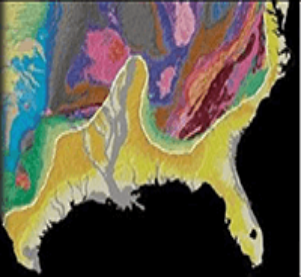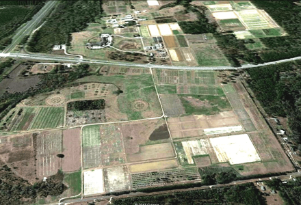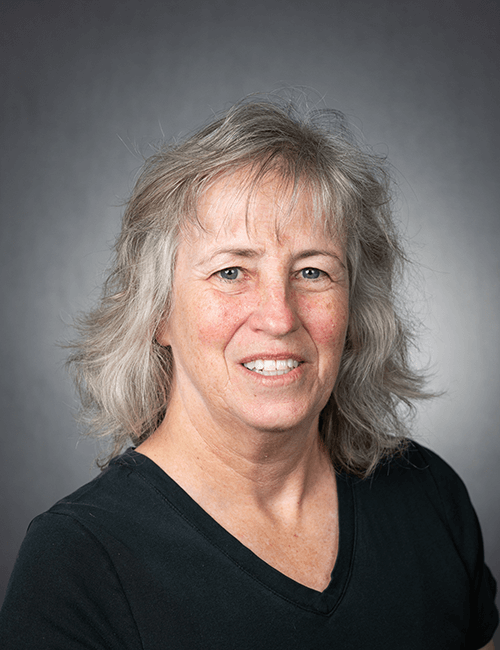Dr. Mackowiak, Cheryl
Associate Professor
Soil and Water Science
North Florida is part of the U.S. Southern Coastal Plain and Atlantic Plain, where the land gently slopes into the Atlantic and Gulf of Mexico, forming our continental shelf. This region is host to over a quarter million farms. The Southern Coastal Plain region was originally comprised of pine savannahs/ woodlands, and wetlands and is noted for its exceptionally high degree of flora and fauna diversity.

USGS Tapestry of the US southern Coastal Plain.
Learn more via the "Atlantic Plain" link above.
Agricultural land clearing increased as the South entered the early 1800s. More than 90% of some southern states went under the plow, mostly for cotton production. The rise of pests, most notably the boll weevil, and the exhaustion of soils from poor management practices resulted in large-scale land abandonment and old-field succession into mostly dense, hardwood forests and pine plantations.
Farming in the U.S. has continued to decline and the average farmer is older now than in any previous time, with only 5% being 35 or younger. It is even worse in the southern and western U.S. Is it possible for a country to remain self-sufficient if almost no one farms? Our national security and quality of life depends on keeping U.S. agriculture and the family farm viable. The average Florida farm is small, at about 200 acres, with the majority at 50 acres or less. These family farms benefit all of us. Besides growing food and fiber, they often conserve green-space. For example, over 50% of Florida farmland is maintained as pasture or woodland. Family farms contribute to the local economy and these folks hold vested interest in the well-being of the local community that they serve.
The North Florida Research and Education Center is committed to supporting agriculture and good land stewardship in Florida and the surrounding region. My research and extension emphasizes the soil and water that sustain the flora and fauna that sustain your agroecological interests and livelihoods.

My research is conducted at NFREC located in Quincy
Florida (above), NFREC Marianna, on-farm, and on public lands.
Programs
-
Research
The intent of my research program is to characterize and enhance the overall quality, and especially chemical fertility, of agroeconomically important soils of the U.S. Southern Coastal Plain. Research projects include the following:
- Developing cool-season forage options for dairies in the southeastern U.S.
- Developing low-input groundcovers for use under photovoltaic collectors
- Developing low-input , dwarf vegetation for Florida Department of Transportation
- Developing an organic sod-based vegetable rotation (post-doc, Christine Bliss)
- Integrating cattle into a sod-based crop rotation
- Fertilization effects on Aristida development (M.S. student, Lisa)
- Effects of silicon management on Asian Soybean Rust pathology in soybean (former M.S. student, Ernane Lemes)
- Developing struvite precipitation methodologies to mitigate municipal wastewater phosphorus (Ph.D. student, John Hallas)
- Using ionophore and winter grazing systems to mitigate nitrogen losses from pastures (M.S. student, Mary Maddox)
-
Extension
The intent of my extension program is to promote good soil stewardship and provide an understanding and appreciation of soil fertility and its interaction with other environmental influences on plant mineral nutrition. My extension programs represent two areas:
Disseminating soil nutrient management trends in forage sustainability
-
Within the past six years, fertilizer costs have increased over 100%, thereby increasing the proportion of a grower’s total operational budget from roughly 12% to ≥30%, particularly for forage hay crops. The producer perspective is that there is a need to reduce the nutrient management costs for their individual forage systems, without jeopardizing production. Promotion of the use of soil sampling reports by county extension faculty and forage producers goes a long way to help with fertilization recommendations. Basic application recommendations and considerations have been developed for some waste products and liming products applied to forages. Over the past 2 years, we have helped to demonstrate the incorporating of perennial peanut forage into a grass-based pasture in order to create a low fertilizer input, but high quality pasture system
Diagnosing forage mineral nutrition and environmental influences
-
Many forage species are not managed with the same degree of attention to their nutrient requirements as those crops labeled as “cash crops. The IFAS recommendations for forages are the most limited in scope as compared with many of the other commodity crops. Extension calls and visits in response to questionable forage nutrient status are among the most common in forage production and demand some of the highest interest among participants in field days and various forage workshops. In many cases weed, disease, pest, or N leaching losses are aggravated by poor plant nutrition. Training the county extension faculty to identify when and how to test forage tissue, how to match results with soil testing, and provide information on some of the most commonly encountered nutritional diseases can save the producer’s current crop and ensure better production of subsequent crops. This program has been used to educate those involved with forage production and environmental protection of the need for balanced plant nutrition and provide awareness of factors that will affect plant nutrient uptake. Approximately 40% of the North Florida forage producers who either call their local agent or my office directly are now aware of the benefits of prudent use of tissue sampling to help diagnose fertilization imbalances, which are up from less than 10% in 2004. High-profile locations, such the Moultrie Georgia Ag Expo, major dairy and cattle producers in Georgia and Florida and field days are used to educate the public on when to sample plant tissue and diagnostic symptoms of some of the more common problems. Due to unusual weather, grass diseases were decimating several bahiagrass pastures and hay fields. We developed a diagnostic tool to help standardize a set of questions the county extension agents can ask the producer. The information will better help us to understand the factors contributing to disease outbreaks and how to manage around them. Take-all disease was prominent in several bahiagrass pastures. We suspect high soil pH and a lack of a balanced fertilization program (applying only N fertilizer) made the plants more susceptible to the disease. We will implement the diagnostic tool in spring, 2012.
-

Contact
Dr. Mackowiak, Cheryl
Associate Professor
Soil and Water Science
North Florida Research and Education Center
155 Research Rd.
Quincy, FL 32351
Phone: 850-875-7126
Fax: 352-846-6617
Email
-
Education
- Ph.D. Utah State University, Soil Fertility and Plant Nutrition, 2001
- M.S. Southern Illinois University, Plant and Soil Science, 1989
- B.S. Southern Illinois University, Plant and Soil Science, 1984
- Publications
